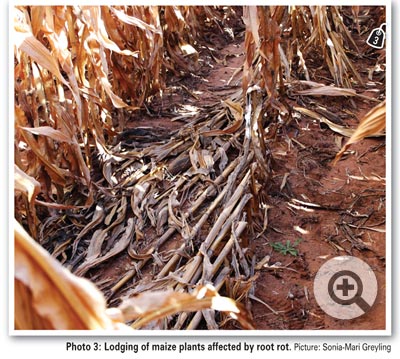September 2013
ANEEN SCHOEMAN AND DR MARYKE CRAVEN, ARC-GRAIN CROPS INSTITUTE, POTCHEFSTROOM
 Root and crown rots and seedling blight are some of the least understood diseases of maize, mostly due to the fact that seedling blights and root rots are the result of a disease complex. This means that there are many fungi involved, which can each differ in their ability to result in disease.
Root and crown rots and seedling blight are some of the least understood diseases of maize, mostly due to the fact that seedling blights and root rots are the result of a disease complex. This means that there are many fungi involved, which can each differ in their ability to result in disease.
Seedling blight and root rots affect the part of the plant that is not visible above ground, thus symptoms often go undetected. Root rot can affect the maize plant in plant stand (Photo 3), plant vigour and eventually affect yield.
Research conducted on maize under South African conditions indicated that a 1,81 ton/ha yield decline can be expected for every unit increase in disease severity, with a unit being, i.e. 1 = >0% - 25% rot, 2 = 25% - 50% rot, 3 = 50% - 75% rot and 4 = 75% - 100% rot. Financial losses suffered by producers can accordingly be significant.
Root rot occurs on every plant in every field, every year, with only the degree and severity varying over seasons. The environment, growth stage of the host plant and preceding crops can impact on the fungi present in the soil and the eventual root rot severity observed.
Isolate pathogenicity, virulence, conservation agriculture (CA) practices, together with soil type and bioclimates contribute to the dynamics and occurrence of soil borne diseases. Variable cultivar susceptibility to various soil borne diseases also contribute to the complexity.
As the maize plant grows, the composition of the fungi in the soil changes due to some isolates being better competitors and/or colonisers of the maize roots. At the seed and seedling stage, seed rot, seedling blight and root rot can occur. Pythium (mostly affecting seed and seedlings, Photo 1A) grows best in soils that are close to saturation point as the zoospores are able to move best in wet soils.
Good drainage is accordingly a good control measure for Pythium. Factors that enhance the occurrence of Pythium, are
soil kept wet for prolonged periods, temperatures that are unfavourable (too low) for host plants, excess nitrogen in soil
and monocropping. Another fungus that might also occur at the seed and seedling stage is Exserohilum pedicellatum (Photo 1B).
Fusarium solani and F. roseum, on the other hand, are regarded to grow very well in dry soils and are, therefore, able to cause more severe disease in drier soils as the plants are more stressed by the lack of water. Therefore flooding might result in a reduction in the number of certain pathogens (such as Fusarium) in the soil by inducing starvation, lack of oxygen or desiccation.
Other fungi that might occur as the maize plants mature, are Rhizoctonia solani (Photo 1C), F. oxysporum, F. Graminearum (Photo 1D), F. verticillioides (Photo 1E), F. chlamydosporum, and F. equiseti (Photo 1F). Information regarding what type of pathogen dominates at a specific growth stage in the maize plant, is necessary in order to know exactly how to manage this disease.
Although crop rotation reduces the incidence of soil borne diseases, reduced tillage practices that form an integral part of CA, create the risk of increased disease incidence. As CA is gaining popularity in the world, it is foreseen that problems associated with root and crown rots will become more prominent.
The ARC-Grain Crops Institute (ARC-GCI) has initiated a root and crown rot project during the 2008/2009 season in order to addresscrown and root rot occurrence over various CA practices. The potential outputs of this project are, however, hampered by laborious plating out and identification procedures.
A new project that commenced during the 2013/2014 season will focus on the development of a rapid and accurate detection method of the different fungi associated with these diseases using molecular technology. The molecular technology that will be used is called a quantitative PCR or qPCR (Photo 2).
This technology uses extracted DNA of the maize roots and crowns and then the presence of a specific fungal pathogen can be identified, as well as quantified. Another advantage of this technology is that it can be used on different plant hosts. The qPCR project will hopefully aid in improving research capacity in order to better understand these diseases and also help to improve management of such diseases.
Currently two sites are sampled three times during the season with the ARC-GCI root and crown rot project. It is important to sample more than once from the same field as soil fungal populations change during the same season.
With the new technology that will be generated, various localities can be sampled more regularly within the same season, providing researchers with a more holistic picture of what is happening with roots and the fungi that colonise them during the season. The advantage will be that producers will be able to get answers to questions about specific diseases much faster.
At the moment costs are R9,67 per qPCR reaction and R30,38 for extraction of DNA per sample, using a plant DNA extraction kit. It is foreseen that analyses requested by producers will accordingly be very cost-effective and affordable.
Producers are welcome to contact Aneen Schoeman or Dr Maryke Craven at the ARC-GCI at 018 299 6100 for more information on root and crown rots.
Publication: September 2013
Section: Input Overview